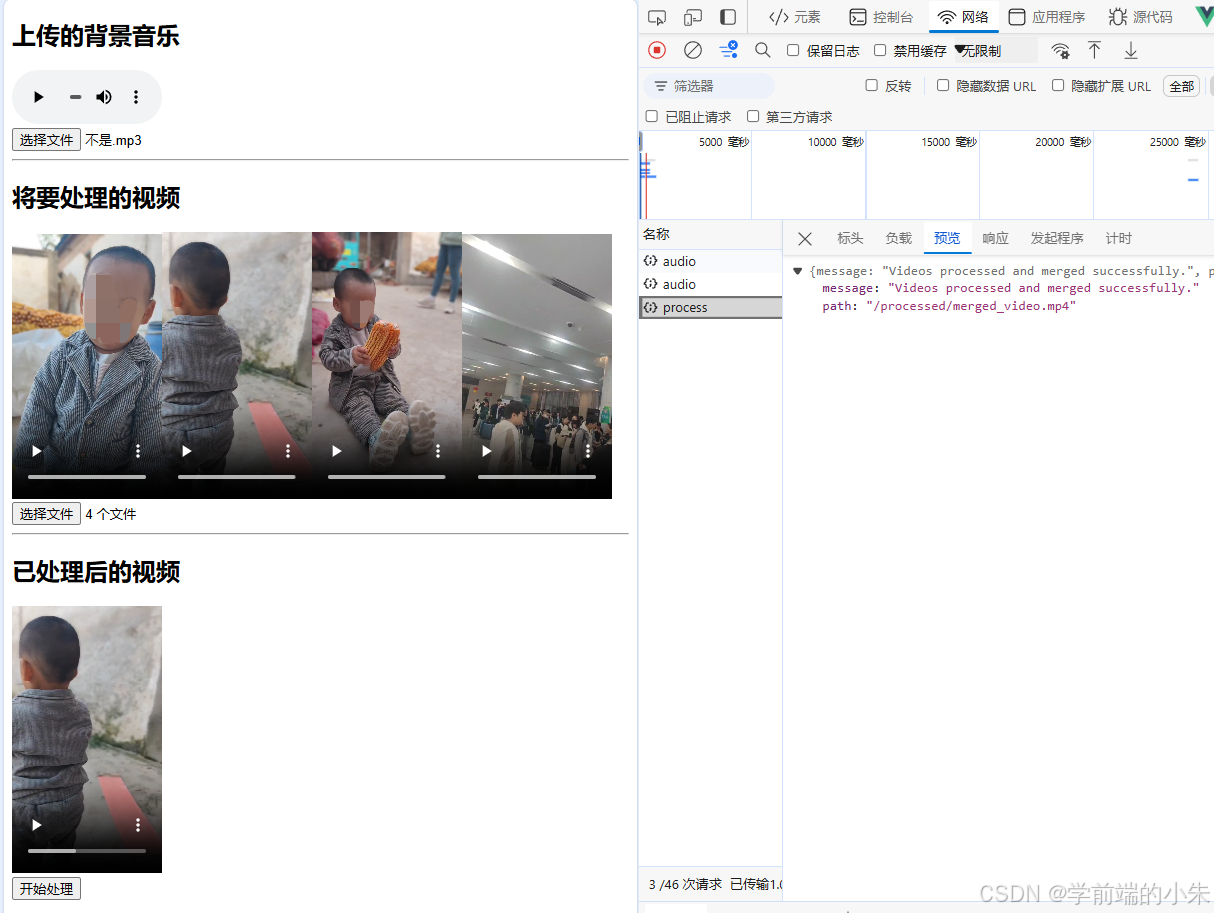一、功能描述
点击背景音乐区域的【选择文件】按钮,选择音频文件并将其上传到服务器,上传成功后会将其存储的位置路径返回。
然后,点击要处理视频区域的【选择文件】按钮选择要进行混剪的视频素材(1-10个)。
以上两步都完成之后点击【开始处理】按钮,后台就开始选择的视频素材先上传到服务器,然后从每个素材中随机抽取 2秒 的内容进行随机混合拼接,接下来将上传的音频融合进拼接好的视频中,最后将处理好的视频输出并将其保存路径返回。
二、效果展示




三、实现代码
说明:
前端代码是使用vue编写的。
后端接口的代码是使用nodejs进行编写的。
3.1 前端代码
<template>
<div id="app">
<!-- 显示上传的音频 -->
<div>
<h2>上传的背景音乐</h2>
<audio
v-for="audio in uploadedaudios"
:key="audio.src"
:src="audio.src"
controls
style="width: 150px"
></audio>
</div>
<!-- 上传视频音频 -->
<input type="file" @change="uploadaudio" accept="audio/*" />
<hr />
<!-- 显示上传的视频 -->
<div>
<h2>将要处理的视频</h2>
<video
v-for="video in uploadedVideos"
:key="video.src"
:src="video.src"
controls
style="width: 150px"
></video>
</div>
<!-- 上传视频按钮 -->
<input type="file" @change="uploadVideo" multiple accept="video/*" />
<hr />
<!-- 显示处理后的视频 -->
<div>
<h2>已处理后的视频</h2>
<video
v-for="video in processedVideos"
:key="video.src"
:src="video.src"
controls
style="width: 150px"
></video>
</div>
<button @click="processVideos">开始处理</button>
</div>
</template>
<script setup>
import axios from "axios";
import { ref } from "vue";
const uploadedaudios = ref([]);
const processedAudios = ref([]);
let audioIndex = 0;
const uploadaudio = async (e) => {
const files = e.target.files;
for (let i = 0; i < files.length; i++) {
const file = files[i];
const audioSrc = URL.createObjectURL(file);
uploadedaudios.value = [{ id: audioIndex++, src: audioSrc, file }];
}
await processAudio();
};
// 上传音频
const processAudio = async () => {
const formData = new FormData();
for (const audio of uploadedaudios.value) {
formData.append("audio", audio.file); // 使用实际的文件对象
}
try {
const response = await axios.post(
"http://localhost:3000/user/single/audio",
formData,
{
headers: {
"Content-Type": "multipart/form-data",
},
}
);
const processedVideoSrc = response.data.path;
processedAudios.value = [
{
id: audioIndex++,
// src: "http://localhost:3000/" + processedVideoSrc,
src: processedVideoSrc,
},
];
} catch (error) {
console.error("Error processing video:", error);
}
};
const uploadedVideos = ref([]);
const processedVideos = ref([]);
let videoIndex = 0;
const uploadVideo = async (e) => {
const files = e.target.files;
for (let i = 0; i < files.length; i++) {
const file = files[i];
const videoSrc = URL.createObjectURL(file);
uploadedVideos.value.push({ id: videoIndex++, src: videoSrc, file });
}
};
const processVideos = async () => {
const formData = new FormData();
formData.append("audioPath", processedAudios.value[0].src);
for (const video of uploadedVideos.value) {
// formData.append("video", video.file); // 使用实际的文件对象
formData.append("videos", video.file); // 使用实际的文件对象
}
console.log(processedAudios.value);
for (const item of formData.entries()) {
console.log(item);
}
try {
const response = await axios.post(
"http://localhost:3000/user/process",
formData,
{
headers: {
"Content-Type": "multipart/form-data",
},
}
);
const processedVideoSrc = response.data.path;
processedVideos.value.push({
id: videoIndex++,
src: "http://localhost:3000/" + processedVideoSrc,
});
} catch (error) {
console.error("Error processing video:", error);
}
};
</script>关于accept 的说明,请查看FFmpeg的简单使用【Windows】--- 简单的视频混合拼接-CSDN博客
3.2 后端代码
routers =》users.js
var express = require('express');
var router = express.Router();
const multer = require('multer');
const ffmpeg = require('fluent-ffmpeg');
const path = require('path');
const { spawn } = require('child_process')
// 视频
const upload = multer({
dest: 'public/uploads/',
storage: multer.diskStorage({
destination: function (req, file, cb) {
cb(null, 'public/uploads'); // 文件保存的目录
},
filename: function (req, file, cb) {
// 提取原始文件的扩展名
const ext = path.extname(file.originalname).toLowerCase(); // 获取文件扩展名,并转换为小写
// 生成唯一文件名,并加上扩展名
const uniqueSuffix = Date.now() + '-' + Math.round(Math.random() * 1E9);
const fileName = uniqueSuffix + ext; // 新文件名
cb(null, fileName); // 文件名
}
})
});
// 音频
const uploadVoice = multer({
dest: 'public/uploadVoice/',
storage: multer.diskStorage({
destination: function (req, file, cb) {
cb(null, 'public/uploadVoice'); // 文件保存的目录
},
filename: function (req, file, cb) {
// 提取原始文件的扩展名
const ext = path.extname(file.originalname).toLowerCase(); // 获取文件扩展名,并转换为小写
// 生成唯一文件名,并加上扩展名
const uniqueSuffix = Date.now() + '-' + Math.round(Math.random() * 1E9);
const fileName = uniqueSuffix + ext; // 新文件名
cb(null, fileName); // 文件名
}
})
});
const fs = require('fs');
// 处理多个视频文件上传
router.post('/process', upload.array('videos', 10), (req, res) => {
const audioPath = path.join(path.dirname(__filename).replace('routes', 'public'), req.body.audioPath)
const videoPaths = req.files.map(file => path.join(path.dirname(__filename).replace('routes', 'public/uploads'), file.filename));
const outputPath = path.join('public/processed', 'merged_video.mp4');
const concatFilePath = path.resolve('public', 'concat.txt').replace(/\\/g, '/');//绝对路径
// 创建 processed 目录(如果不存在)
if (!fs.existsSync("public/processed")) {
fs.mkdirSync("public/processed");
}
// 计算每个视频的长度
const videoLengths = videoPaths.map(videoPath => {
return new Promise((resolve, reject) => {
ffmpeg.ffprobe(videoPath, (err, metadata) => {
if (err) {
reject(err);
} else {
resolve(parseFloat(metadata.format.duration));
}
});
});
});
// 等待所有视频长度计算完成
Promise.all(videoLengths).then(lengths => {
// 构建 concat.txt 文件内容
let concatFileContent = '';
// 定义一个函数来随机选择视频片段
function getRandomSegment(videoPath, length) {
const segmentLength = 2; // 每个片段的长度为2秒
const startTime = Math.floor(Math.random() * (length - segmentLength));
return {
videoPath,
startTime,
endTime: startTime + segmentLength
};
}
// 随机选择视频片段
const segments = [];
for (let i = 0; i < lengths.length; i++) {
const videoPath = videoPaths[i];
const length = lengths[i];
const segment = getRandomSegment(videoPath, length);
segments.push(segment);
}
// 打乱视频片段的顺序
function shuffleArray(array) {
for (let i = array.length - 1; i > 0; i--) {
const j = Math.floor(Math.random() * (i + 1));
[array[i], array[j]] = [array[j], array[i]];
}
return array;
}
shuffleArray(segments);
// 构建 concat.txt 文件内容
segments.forEach(segment => {
concatFileContent += `file '${segment.videoPath.replace(/\\/g, '/')}'\n`;
concatFileContent += `inpoint ${segment.startTime}\n`;
concatFileContent += `outpoint ${segment.endTime}\n`;
});
fs.writeFileSync(concatFilePath, concatFileContent, 'utf8');
// 获取视频总时长
const totalVideoDuration = segments.reduce((acc, segment) => acc + (segment.endTime - segment.startTime), 0);
// 获取音频文件的长度
const getAudioDuration = (filePath) => {
return new Promise((resolve, reject) => {
const ffprobe = spawn('ffprobe', [
'-v', 'error',
'-show_entries', 'format=duration',
'-of', 'default=noprint_wrappers=1:nokey=1',
filePath
]);
let duration = '';
ffprobe.stdout.on('data', (data) => {
duration += data.toString();
});
ffprobe.stderr.on('data', (data) => {
console.error(`ffprobe stderr: ${data}`);
reject(new Error(`Failed to get audio duration`));
});
ffprobe.on('close', (code) => {
if (code !== 0) {
reject(new Error(`FFprobe process exited with code ${code}`));
} else {
resolve(parseFloat(duration.trim()));
}
});
});
};
getAudioDuration(audioPath).then(audioDuration => {
// 计算音频循环次数
const loopCount = Math.floor(totalVideoDuration / audioDuration);
// 使用 ffmpeg 合并多个视频
ffmpeg()
.input(audioPath) // 添加音频文件作为输入
.inputOptions([
`-stream_loop ${loopCount}`, // 设置音频循环次数
])
.input(concatFilePath)
.inputOptions([
'-f concat',
'-safe 0'
])
.output(outputPath)
.outputOptions([
'-y', // 覆盖已存在的输出文件
'-c:v libx264', // 视频编码器
'-preset veryfast', // 编码速度
'-crf 23', // 视频质量控制
'-map 0:a', // 选择第一个输入(即音频文件)的音频流
'-map 1:v', // 选择所有输入文件的视频流(如果有)
'-c:a aac', // 音频编码器
'-b:a 128k', // 音频比特率
'-t', totalVideoDuration.toFixed(2), // 设置输出文件的总时长为视频的时长
])
.on('end', () => {
const processedVideoSrc = `/processed/merged_video.mp4`;
console.log(`Processed video saved at: ${outputPath}`);
res.json({ message: 'Videos processed and merged successfully.', path: processedVideoSrc });
})
.on('error', (err) => {
console.error(`Error processing videos: ${err}`);
console.error('FFmpeg stderr:', err.stderr);
res.status(500).json({ error: 'An error occurred while processing the videos.' });
})
.run();
}).catch(err => {
console.error(`Error getting audio duration: ${err}`);
res.status(500).json({ error: 'An error occurred while processing the videos.' });
});
}).catch(err => {
console.error(`Error calculating video lengths: ${err}`);
res.status(500).json({ error: 'An error occurred while processing the videos.' });
});
// 写入 concat.txt 文件
const concatFileContent = videoPaths.map(p => `file '${p.replace(/\\/g, '/')}'`).join('\n');
fs.writeFileSync(concatFilePath, concatFileContent, 'utf8');
});
// 处理单个音频文件
router.post('/single/audio', uploadVoice.single('audio'), (req, res) => {
const audioPath = req.file.path;
console.log(req.file)
res.send({
msg: 'ok',
path: audioPath.replace('public', '').replace(/\\/g, '/')
})
})
module.exports = router;
注意:
关于multer配置项 和 ffmpeg() 的说明可移步进行查看FFmpeg的简单使用【Windows】--- 视频倒叙播放-CSDN博客
3.2.1 ffprobe
1、什么是ffprobe
ffprobe是FFmpeg套件中的一个工具,用于提取媒体文件的元数据,它可以获取各种媒体文件的信息,包括视频、音频和其他媒体数据。
2、使用步骤
在JavaScript中,我们通常通过第三方库(如fluent-ffmpeg)来调用ffprobe。以下是如何使用ffluent-ffmpeg库调用ffprobe的示例:
const ffmpeg = require('fluent-ffmpeg');
// 定义视频文件路径
const videoPath = 'path/to/video.mp4';
// 调用 ffmpeg.ffprobe
ffmpeg.ffprobe(videoPath, (err, metadata) => {
if (err) {
console.error('Error running ffprobe:', err);
return;
}
console.log('Metadata:', metadata);
});3、详细解释
ffmpeg.ffprobe(videoPath, callback)
⚫videoPath:视频文件的路径
⚫callback:一个回调函数,接收两个参数 err 和 metadata
🌠 err:如果执行过程中出现错误,err为错误对象,否则为null。
🌠 metadata:如果成功执行,metadata为一个包含媒体文件元数据的对象。
🌠 metadata对象包含了媒体文件的各种信息,主要包括:
🛹 format:格式级别的元数据
🛴 duration:视频的总持续时间(秒)
🛴 bit_rate:视频的比特率(bps)
🛴 size:视频文件大小(字节)
🛴 start_time:视频开始时间(秒)
🛹 streams:流级别的元数据
🛴 每个流(视频、音频等)的信息
🛴 每个流都有自己的index、codec_type、codec_name等属性
3.2.2 getAudioDuration()的说明:
⚫ 定义:getAudioDuration是一个接收filePath参数的喊出,返回一个Promise对象。
⚫ 参数:filePath表示音频文件的路径。
⚫ spawn方法:通过child_process模块创建一个子进程,运行ffprobe命令。
⚫ spawn参数:
🌠 -v error:只显示错误信息。
🌠 -show_entries format=duration:显示格式级别的duration属性。
🌠 -of default=noprint_wrappers=1:nokey=1:输出格式为纯文本,没有额外的包装。
🌠 filePath:音频文件的路径。
⚫监听stdout事件:放ffprobe子进程有数据输出时,将其转换为字符串并累加到duration变量值。
⚫监听stderr事件:当ffprobe子进程有错误输出时,打印错误信息,并拒绝Promise。
⚫监听close事件:当ffprobe子进程关闭时触发。
⚫状态码检查:
🌠 code ≠ 0:表示有错误发生,拒绝Promise并抛出错误。
🌠 code = 0:表示成功执行,解析duration变量并解析为浮点数,然后解析Promise。






![[CS报错] error CS1617: /langversion 的选项“12”无效。使用 “/langversion:?“ 列出支持的值](https://i-blog.csdnimg.cn/direct/dfaaf544c2ae47d9bdca127285e58a9b.png)











